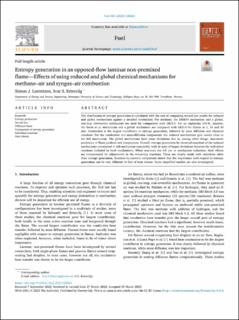| dc.contributor.author | Lorentzen, Simon Johan | |
| dc.contributor.author | Ertesvåg, Ivar Ståle | |
| dc.date.accessioned | 2023-04-12T09:17:38Z | |
| dc.date.available | 2023-04-12T09:17:38Z | |
| dc.date.created | 2023-04-03T11:11:33Z | |
| dc.date.issued | 2023 | |
| dc.identifier.citation | Fuel. 2023, 345 . | en_US |
| dc.identifier.issn | 0016-2361 | |
| dc.identifier.uri | https://hdl.handle.net/11250/3062571 | |
| dc.description.abstract | The distribution of entropy generation is calculated with the aim of comparing second-law results for reduced and global mechanisms against a detailed mechanism. For methane, the DRM19 mechanism and a global, one-step irreversible mechanism are used for comparison with GRI3.0. For an equimolar CO/H2 mixture, the Davis et al. mechanism and a global mechanism are compared with GRI3.0 for flames at 1, 10 and 20 atm. Conduction is the largest contributor to entropy generation, followed by mass diffusion and chemical reactions. For the conduction and mass-diffusion components, the reduced mechanisms give results close to the full mechanism. The global mechanisms have some deviations due to, among other things, inaccurate prediction of flame position and temperature. Overall, entropy generation by chemical reactions of the reduced mechanisms correspond to full mechanism reasonably well, in spite of larger deviations between the individual reactions included in both mechanisms. When reactions are left out in mechanism reduction, their effects are compensated by adjustments in the remaining reactions. These are clearly made with objectives other than entropy generation. Reaction-by-reaction comparison shows that the importance with respect to entropy generation can be very different to that of heat release. Some simplified models are also investigated. | en_US |
| dc.language.iso | eng | en_US |
| dc.publisher | Elsevier | en_US |
| dc.rights | Navngivelse 4.0 Internasjonal | * |
| dc.rights.uri | http://creativecommons.org/licenses/by/4.0/deed.no | * |
| dc.title | Entropy generation in an opposed-flow laminar non-premixed flame—Effects of using reduced and global chemical mechanisms for methane–air and syngas–air combustion | en_US |
| dc.title.alternative | Entropy generation in an opposed-flow laminar non-premixed flame—Effects of using reduced and global chemical mechanisms for methane–air and syngas–air combustion | en_US |
| dc.type | Journal article | en_US |
| dc.type | Peer reviewed | |
| dc.description.version | publishedVersion | en_US |
| dc.description.version | Accepted version | |
| dc.source.pagenumber | 13 | en_US |
| dc.source.volume | 345 | en_US |
| dc.source.journal | Fuel | en_US |
| dc.identifier.doi | 10.1016/j.fuel.2023.128263 | |
| dc.identifier.cristin | 2139202 | |
| cristin.ispublished | true | |
| cristin.fulltext | original | |
| cristin.qualitycode | 2 | |

